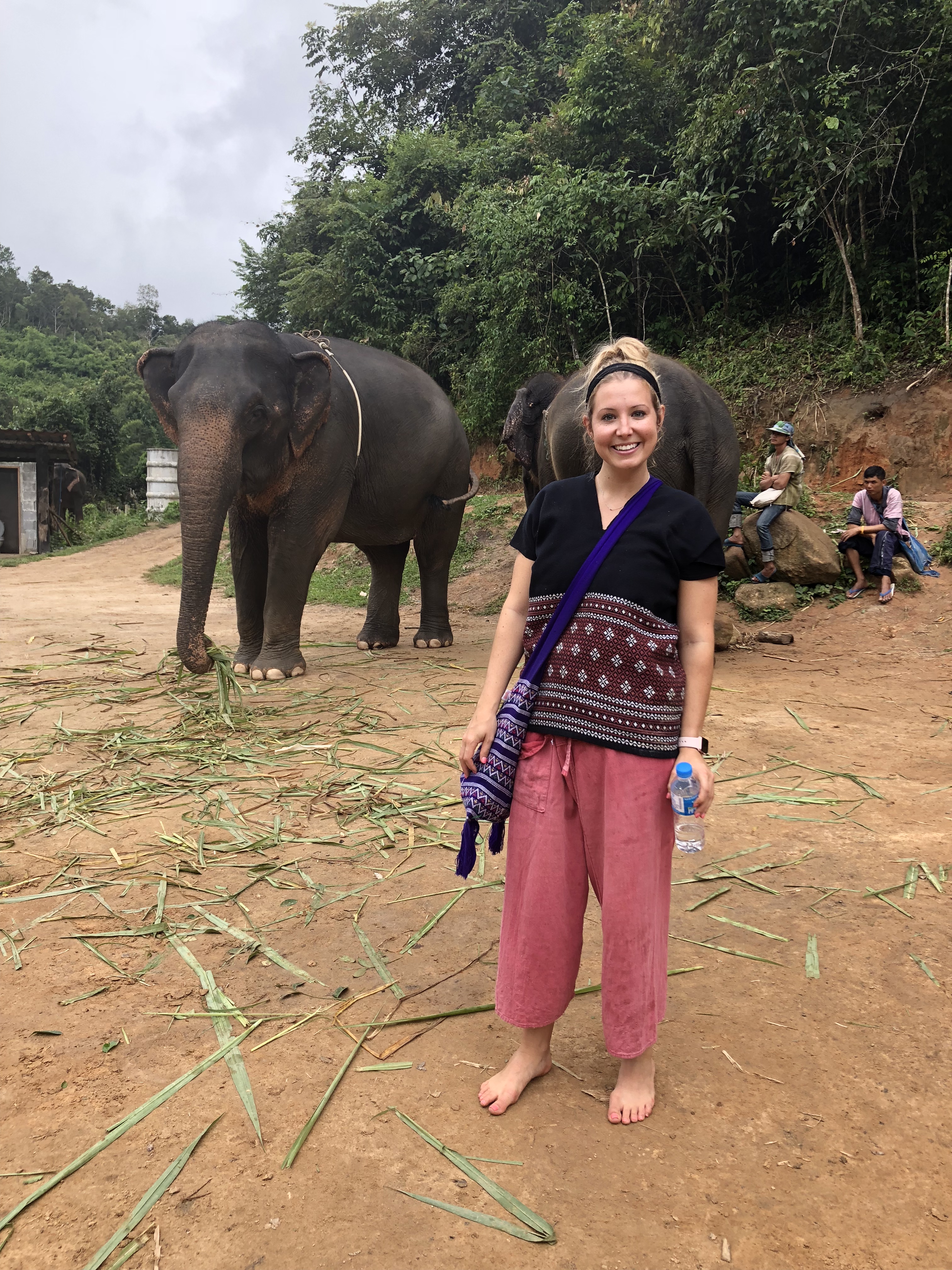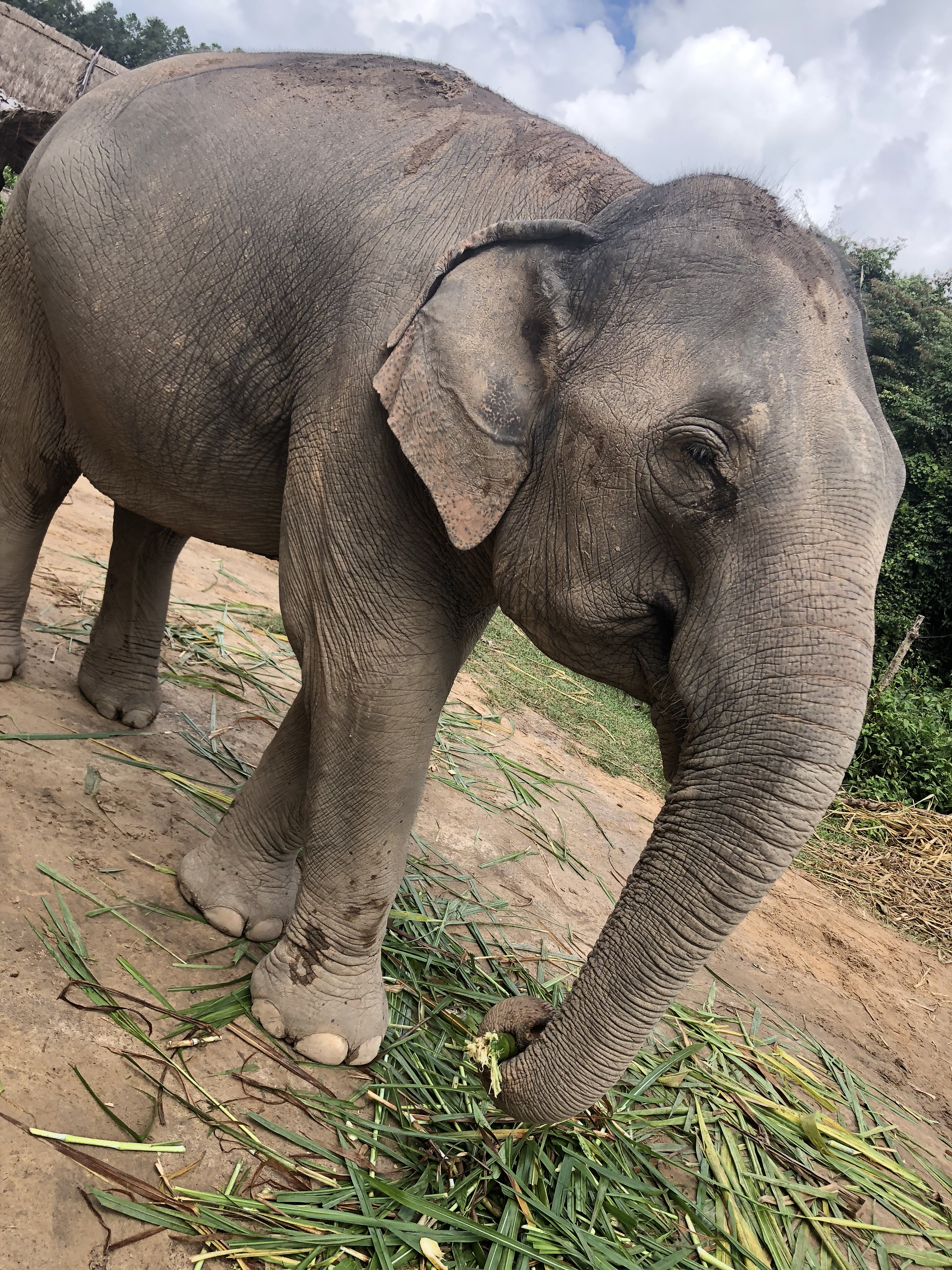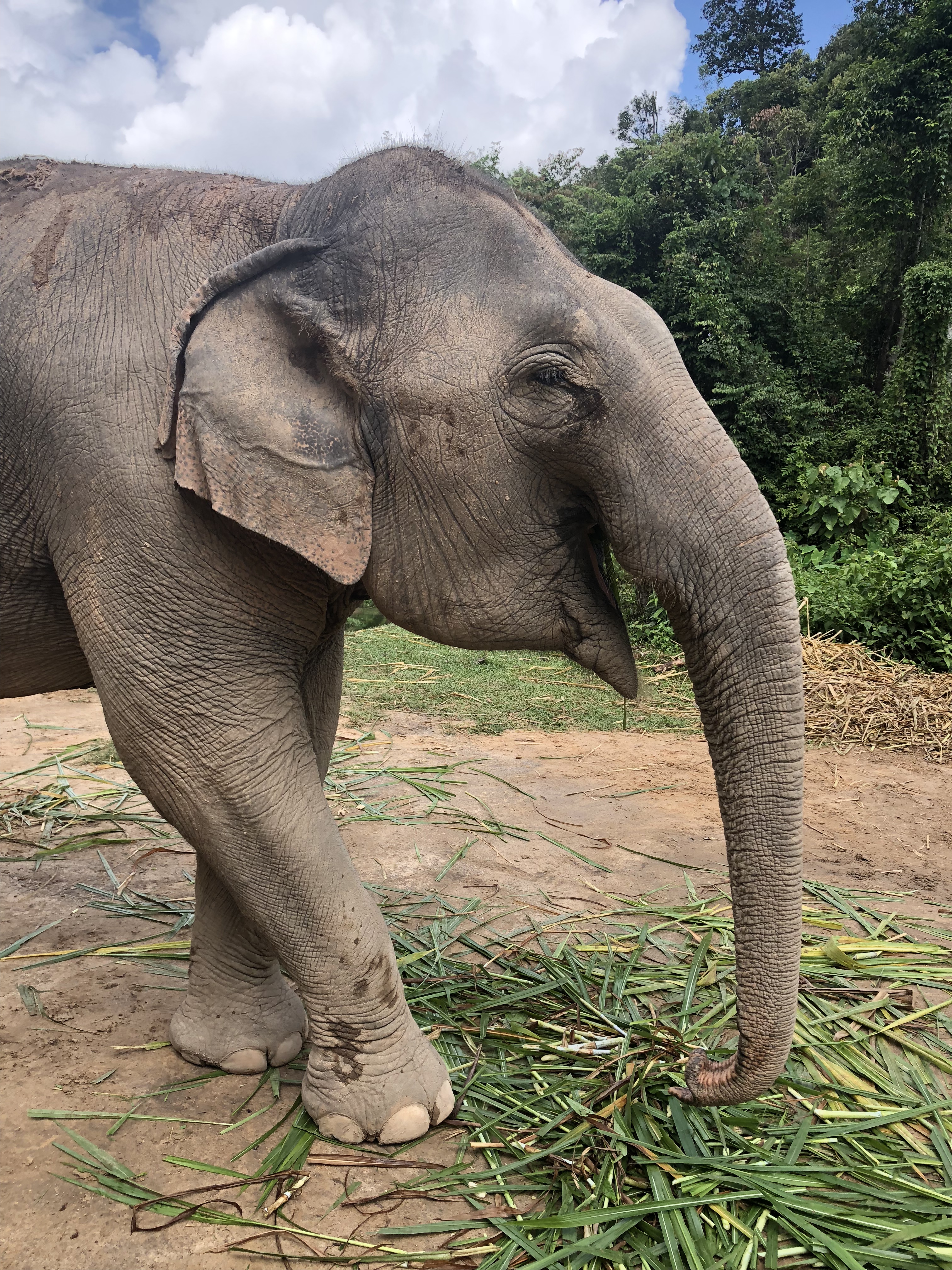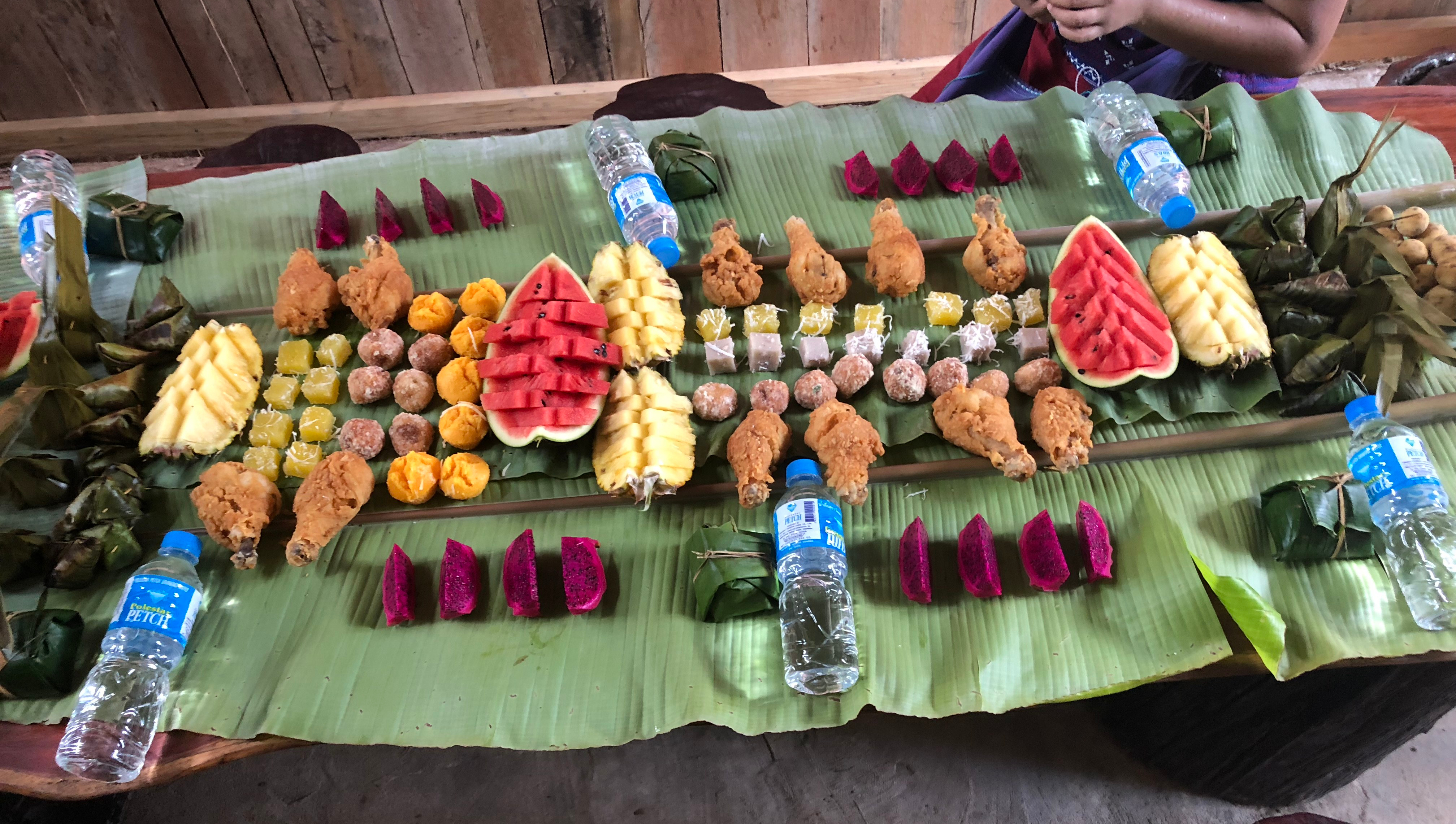Note: I pulled together the following information based on my research and my experience. I wasn’t able to find as much information as I wanted before going to Thailand, and have tried to include some of the things that I wanted to know beforehand. All thoughts expressed below are my own based on my currently knowledge and understanding.
As soon as I knew that I was going to Thailand, the first thing that I went to book was some sort of excursion that involved me meeting an elephant because who doesn’t want to see an elephant up close and personal at least once in her life!? I set off on the internet to do some research, starting with Trip Advisor, then moving to Pinterest and other travel blogs to check out my options. I immediately started seeing all of the posts about what is considered “ethical” and to make sure that you are ABSOLUTELY POSITIVELY NOT going somewhere where they allow you to ride the elephants. Post after post alerted me that riding elephants in any way is unethical and advised not to give my money to a company that allows you to ride them. My mom even sent a post she found that was solely dedicated talking about how unethical it is to ride the elephants.
SCARY. I don’t want to be responsible for hurting an animal. That’s not okay with me. So I keep researching and find a couple of “ethical” elephant tours based in Chiang Mai but wasn’t thrilled with the opportunities available for the amount of money that I would be spending. Then I somehow stumbled across a very positive review for the Karen Tribe Native Elephants (different Karen Tribe from the long-neck Karen Tribe). The tribe practices ecotourism to raise awareness and also to raise funds to continue to take care of the elephants owned by the tribe. I liked the sound of this opportunity and started looking more into it, finding very little information on the internet other that what was included on the website (linked above). I did come across one other blog about the Karen Tribe Native Elephants and found out that they do allow for riding of elephants, but the other blogger had some information that contradicted what I’d read previously. I decided to take the plunge and book, knowing that if I felt uncomfortable and didn’t want to ride once I got there, I could politely decline. As I mentioned, there was very little information available online, so I emailed inquiring about a visit and was quickly confirmed. They said that I could pay on the day of (even though I booked months in advance) and just asked that I don’t “ghost” them. Hmm, they are pretty trusting of the tourists (more so than I would be knowing how people act these days).
The Experience
Fast forward two months and I am in Chiang Mai and beyond excited to spend the day with the elephants. We had a little mixup in communication and the driver went to the wrong hotel to pick me up, but eventually we connected, I was picked up and we went on our way. It was about a two-hour drive to the village of the Karen Tribe, and the car ride would not be easy for those who easily get carsick. The drive up the mountain started on wide paved roads, then transitioned to narrow paved roads, the to a combination of dirt roads and paved roads that were crumbling in the street, and then at some points mud roads as it had been raining on and off during the day. The drive is definitely not “smooth,” but you do what you gotta do to see some beautiful creatures up close.
Once we arrived, we first made a stop to see a few of the elephants that we would not be working with during the day, including a BABY.
Side note – If anyone is wondering what a baby elephant acts like, just imagine a 1000 pound toddler running around and getting into EVERYTHING! In the 30 minutes we were there, he tried to go into the house three or four times, he knocked over the parked motorcycles and scooters probably six or seven times, he kept sneaking food when no one was guarding it and would run away whenever anyone tried to grab him. Whew! Glad I don’t have to care for one of those on a regular basis! I think spending a few minutes her with would make any mom appreciate that their toddlers weight only 20 (or 30?) pounds.
I was a little overwhelmed in these first 30 minutes, trying to get myself comfortable with the size of the elephants and just the craziness with the baby running around. I was given a basket of bananas to feed them so that we could all get comfortable with each other. The grown elephants were polite and would reach their trunks out, asking for one (although one of them was hoarding and holding like seven bananas in her trunk at once), but the baby came right up to me and stuck his trunk in the basket and started rummaging around for the perfect banana. It was adorable.
I then learned that the elephants can hug and kiss and I think these pictures sum up my reaction better than I could with words! [The kiss was like someone stuck a wet suction cup on my face and then pulled it off HAHA!]
Once this meet and greet was over, we drove another 5 minutes to meet the elephants that we were caring for that day. There were six of us total (the maximum visitors the tribe allows each day is 8 people – 2 per elephant) so you know that you’re really getting that hands on opportunity that is not offered in other “ethical” elephant activities. One other girl and I had both opted to pay a little more to have an elephant to ourselves (I am selfish and didn’t want to share with a stranger).
 We were given the traditional Karen Tribe clothing to wear and the leader of the tribe gave us some background information about his village, the Mae La Kee village. The village is made up of 65 families with over 300 people and all of the food that they eat is produced on their land. Many families within the tribe have owned elephants for hundreds of years, as the elephants used to be used for farming and forestry (similar to how we used horses and cattle in the States). One example is that they used to help with the harvesting of the rice fields, which was a month-long process by elephant. With newer technologies, this can now be done in just days. The elephants no longer have any use to the village but cannot be returned to the wild, so the tribe has turned its focus to taking care of the elephants to ensure that they are happy and healthy and to keep making elephant babies to counteract the decreasing population of elephants in Thailand (total elephants in Thailand has decreased from 6,000 to 4,500 in just FOURTY years). The mating process is all natural and when a female elephant is baby ready, the tribe sends the female and a male elephant out for a “honeymoon” for some baby-making. They usually return a few days later and the tribe then monitors to see if she got pregnant during the trip (insert witty joke directed at the honeymooners visiting with us!).
We were given the traditional Karen Tribe clothing to wear and the leader of the tribe gave us some background information about his village, the Mae La Kee village. The village is made up of 65 families with over 300 people and all of the food that they eat is produced on their land. Many families within the tribe have owned elephants for hundreds of years, as the elephants used to be used for farming and forestry (similar to how we used horses and cattle in the States). One example is that they used to help with the harvesting of the rice fields, which was a month-long process by elephant. With newer technologies, this can now be done in just days. The elephants no longer have any use to the village but cannot be returned to the wild, so the tribe has turned its focus to taking care of the elephants to ensure that they are happy and healthy and to keep making elephant babies to counteract the decreasing population of elephants in Thailand (total elephants in Thailand has decreased from 6,000 to 4,500 in just FOURTY years). The mating process is all natural and when a female elephant is baby ready, the tribe sends the female and a male elephant out for a “honeymoon” for some baby-making. They usually return a few days later and the tribe then monitors to see if she got pregnant during the trip (insert witty joke directed at the honeymooners visiting with us!).
While the elephants belong to certain families, the whole tribe (and the visitors) help to take care of them because they are a lot of work! Each elephant eats an unbelievable amount of food per day and they are required to be bathed and taken out for exercise on a daily basis. It is very important to take care of their skin, especially, to prevent illness and promote healthiness. We learned five different things that are checked daily to check on the health of each elephant and learned more about the diet and habits of the elephants. After this lesson, we learned a few phrases and commands to be used during the day and we were introduced to our elephant for the day. I was paired up with a 33-year-old female elephant named Mae Boo Tor, who was pregnant and learned that elephants are pregnant for two years. Wow! So glad I’m not an elephant!

Isn’t she beautiful?!

And so happy! (This may or may not have been right after feeding time)
We kicked off our meeting by feeding the elephants so that we could develop a relationship with them before moving on. After feeding a diet of bananas, sugarcane and grass, we bathed the elephants. We started by brushing off all of the dry dirt and then moved into the river so that we could scrub them down. I can’t remember exactly what we used to wash them, but it was a natural plant that Mae Boo Tor kept trying to grab out of my hands with her trunk. I later learned that it’s something that they like to eat as well. In usual pregnant lady fashion, Mae Boo Tor didn’t stop eating the entire time that we were together (you’ll hear more about this later…).
Once the elephants were all clean, we cleaned ourselves off and it was time to take them for a walk for exercise. At this point, some more information was given about the riding of the elephants. While the elephant’s backs aren’t meant to carry a lot of weight and putting a saddle and loading up several people can hurt the elephants, their necks are especially strong and can handle the weight of one human. When the elephants were used for work, they carried much heavier supplies across their necks. When you do the math, I weight such a small fraction of the elephant’s total body weight – putting me on top of an elephant is like me putting something that weights 1.5 pounds on my shoulders. While sitting on the elephant, I felt like I was like a pair on sunglasses sitting atop her head with my legs locked behind her ears. The point was also made that we put saddles on horses and ride them, especially in the US, and they are much smaller than elephants (do we talk about this as an unethical practice the same way as elephants? I don’t even know!). **At this point, I’m wondering about PETA’s take on elephants since they have an opinion on everything – see below for some added discussion that makes me feel even better about the Karen Tribe elephants!** Also, the members of the tribe ride them on a regular basis for exercise or to move them around the village. I decided that I felt comfortable and I felt 100% that this practice is ethical, despite what other tourism companies may say, so here are the pictures of me (so gracefully…) getting onto Mae Boo Tor. You can see one of the tribe members laughing at me in the last picture below.
We set off for a one hour walk, which started with climbing up a ridiculously steep hill. The elephants set off and we were the last in line. The members of the tribe that were handling the elephants got the first up the hill and all other followed suit…except us. We made it up the hill and then Mae Boo Tor turned around and started going back down the hill in search of some food. All of the others had already started walking around to get to the trail since the hill was too steep for the people the climb, so I frantically called out not to leave me and everyone came running over to get her butt turned around and get her to follow the crowd. For the entire walk, we lagged behind because Mae Boo Tor stopped every 5 meters to look for some food. At one point, she took a whole tree down and tried to carry it with her to munch on. Her trainer had to stop and cut it into pieces so she could carry it all.
I felt like it was a scene out of a movie! Also, around this point, I decided that I was destined to be paired with Mae Boo Tor because she’s my spirit animal. 🐘🐘🐘
 After our walk, one of the ladies had prepared a lunch spread for us that was unbelievably delicious. We had fried chicken that was better than any fried chicken I’ve ever eaten before in my life, and since they live off their land only, I have a feeling it was also the healthiest fried chicken I’d ever had as well. The fruits and desserts were also so yummy and I easily ate enough for two people (I had the spirit of Mae Boo Tor in me).
After our walk, one of the ladies had prepared a lunch spread for us that was unbelievably delicious. We had fried chicken that was better than any fried chicken I’ve ever eaten before in my life, and since they live off their land only, I have a feeling it was also the healthiest fried chicken I’d ever had as well. The fruits and desserts were also so yummy and I easily ate enough for two people (I had the spirit of Mae Boo Tor in me).
After lunch, we had one more task to do for the day before wrapping up. We broke into groups and made medicine balls for the elephants out of all natural ingredients such as rice, sugarcane, pepper, salt, and a bunch of other things that I can’t remember. Similar to our vitamins, each of the ingredients helps with something covering all aspects of the animals’ health from digestion to skin.
Similar to ALL OF THE OTHER FOOD the elephants just ate these up. They really like to eat! While cleaning up, Mae Boo Tor came over and wanted a rinse so I used the hose to spray her to cool off, and then she used her trunk to lower the hose from my hand when she was done. So stinking smart! At this point, it was time to say goodbye to the animals, and while I was sad to leave, I was exhausted after a hard day of work and was ready to get back to the city.
Final Consensus
This was one of the best things that I have experienced in my life. I am now so much more informed, and I learned how much work goes into taking care of these beautiful creatures. I have such an appreciation for this Karen Tribe for doing their part in caring for their elephants but also in promoting procreation among their elephants and caring for the babies, knowing that it will be a lot of additional work for the village. I HIGHLY recommend spending your day with the Mae La Kee Village Karen Tribe and helping to care for their elephants if you have a day to spare when visiting Chiang Mai (and would probably recommend a trip to Chiang Mai just to do this). I am so glad that I stumbled across a review because the tribe does not promote through marketing or local tourism companies, but relies on word of mouth. So this is me telling you to go and put in the work if you have any interest in elephants and you absolutely will not regret it! I am so glad that I chose to spend my time with the Mae La Kee Village Karen Tribe and will go back in a heartbeat when I make it back to Thailand.
**PETA’s thoughts on elephants in Thailand
“The animal-entertainment industry is catching on, and many cruel roadside zoos and breeding facilities are now marketing their animal prisons as “sanctuaries” or “rescues” and claiming to support species conservation in order to attract customers.” – PETA
According to this PETA article, there are 9 reasons why elephant rides are not ethical and I can confidently respond to most of the reasons, which furthers my appreciation for the Mae La Kee Village Karen Tribe and their efforts to keep these elephants happy and healthy, and also give me further confidence in my decision to ride. I am also glad that I didn’t go to one of the other “sanctuaries” because I lost confidence that they are truly ethical after reading some of these articles (that’s not to say that they are not ethical – I would need to do additional research). See my comments below.
“1. When they’re babies, elephants are taken from their mothers and families in the wild. Because they have a high sale value, not only are babies illegally captured, their protective mothers are also often killed as they try to save them. I can’t speak to this as the elephants have been in the tribe for years and years.
2. “Training” begins immediately. The babies are tied down and beaten with bullhooks and other instruments designed to inflict pain until their spirits are broken and they’re willing to obey their “trainers” to avoid pain. Not once did I see the use of ropes or bullhooks on any of the elephants and none of them had any scars anywhere (including behind the ears, which according to PETA is a common areas for using bullhooks). The elephants all responded to commands and in the case of the baby, they were using their bodies to block her or arms and/or food to guide her around when she didn’t listen.
3. Researchers have found that elephants who are subjected to this “breaking” or “crush” process often develop post-traumatic stress disorder. I don’t believe that there is any “breaking” involved. See above.
4. Elephants in nature live in matriarchal herds in which they forage for fresh vegetation, play, bathe in rivers, and travel many miles a day. Held in captivity, they can move only in small circles in an arena or along a short path while carrying humans on their backs, even on the hottest days. From my understanding, the elephants roam around the vast expanse of land owned by the tribe. They only carry human (one at a time) on their shoulders when they need to be moved around and they are taken out for exercise and given the opportunity to do all of the things listed EVERY DAY (I saw it with my own two eyes).
5. When they aren’t working, the animals are usually kept in sheds or shacks—often with concrete floors that damage their legs—and they’re bound by chains that can be so tight they can barely move. See above. It is my understanding that they are not contained with chains or in shacks.
6. Captive elephants are routinely denied nutritious food, adequate water, and needed veterinary care, especially for their feet. These elephants are provided sufficient food and water every day and see a veterinarian quarterly (if I recall correctly) and are checked daily by the tribe (including their feet, which was one of the five items I noted above).
7. The lack of exercise and long hours spent standing on hard surfaces are major contributors to serious foot problems, arthritis, and back injuries. Most captive elephants die decades short of their normal lifespan. These elephants are exercising daily and their feet are checked daily for any issues.
8. According to World Animal Protection, “Between 2010 and 2016 in Thailand alone, 17 fatalities and 21 serious injuries to people by captive elephants were reported in the media. Unreported incidences involving local elephant keepers are likely to make this figure much higher.” I cannot speak to any incidents that have occurred.
9. Because public awareness of cruelty to captive elephants has increased, many attractions are trying to dupe tourists by adding words such as “sanctuary,” “rescue center,” “refuge,” and “retirement facility” to their names. But the abusive training methods and deprivation are often the same and make the elephants follow the trainers’ commands to let people ride, feed, touch, or bathe them.” The tribe is not a sanctuary, rescue center, refuge, etc. These are elephants that were previously used for work that no longer provide an economic benefit to the village, but the tribe is doing its part to continue to care for the elephants. I saw no abuse or deprivation (honestly, they are taken care of better than I take care of myself!).





















Very interesting post – I have no desire to go to that part of the world (I’d starve to death lol) but working with the elephants sounded fascinating but a lot of hard work. Glad you enjoyed it. I have a thing for camels (got my picture published in a Turkish newspaper sitting on one on their opening day of tourism season) and love penguins but have never interacted with any.